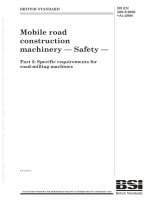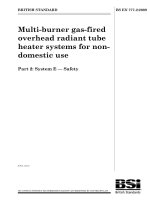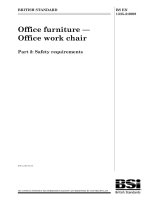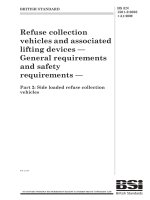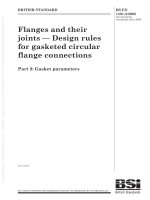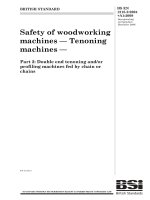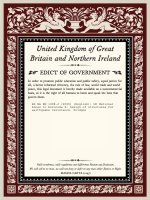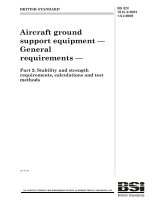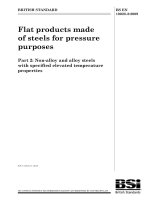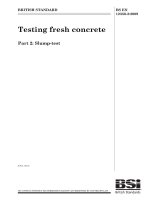Bsi bs en 61249 2 37 2009
Bạn đang xem bản rút gọn của tài liệu. Xem và tải ngay bản đầy đủ của tài liệu tại đây (1.75 MB, 26 trang )
BS EN 61249-2-37:2009
BSI British Standards
Materials for printed boards
and other interconnecting
structures —
Part 2-37: Reinforced base materials, clad and
unclad — Modified non-halogenated epoxide
woven E-glass laminate sheets of defined
flammability (vertical burning test), copper-clad
for lead-free assembly
NO COPYING WITHOUT BSI PERMISSION EXCEPT AS PERMITTED BY COPYRIGHT LAW
raising standards worldwide™
BRITISH STANDARD
BS EN 61249-2-37:2009
National foreword
This British Standard is the UK implementation of EN 61249-2-37:2009. It is
identical to IEC 61249-2-37:2008.
The UK participation in its preparation was entrusted to Technical Committee
EPL/501, Electronic assembly technology.
A list of organizations represented on this committee can be obtained on
request to its secretary.
This publication does not purport to include all the necessary provisions of a
contract. Users are responsible for its correct application.
© BSI 2009
ISBN 978 0 580 58819 8
ICS 31.180
Compliance with a British Standard cannot confer immunity from
legal obligations.
This British Standard was published under the authority of the Standards
Policy and Strategy Committee on 30 April 2009
Amendments issued since publication
Amd. No.
Date
Text affected
BS EN 61249-2-37:2009
EUROPEAN STANDARD
EN 61249-2-37
NORME EUROPÉENNE
March 2009
EUROPÄISCHE NORM
ICS 31.180
English version
Materials for printed boards and other interconnecting structures Part 2-37: Reinforced base materials, clad and unclad Modified non-halogenated epoxide woven E-glass laminate sheets
of defined flammability (vertical burning test),
copper-clad for lead-free assembly
(IEC 61249-2-37:2008)
Matériaux pour circuits imprimés
et autres structures d'interconnexion Partie 2-37: Matériaux de base renforcés,
plaqués et non plaqués Feuilles stratifiées en tissu de verre
de type E époxyde modifié non halogéné,
plaquées cuivre, d'inflammabilité définie
(essai de combustion verticale)
pour les assemblages sans plomb
(CEI 61249-2-37:2008)
Materialien für Leiterplatten
und andere Verbindungsstrukturen Teil 2-37: Kaschierte und unkaschierte
verstärkte Basismaterialien Kupferkaschierte mit E-Glasgewebe
verstärkte Laminattafeln auf der Basis
von modifiziertem halogenfreiem
Epoxidharz mit definierter Brennbarkeit
(Brennprüfung mit vertikaler Prüflingslage)
für bleifreie Bestückungstechnik
(IEC 61249-2-37:2008)
This European Standard was approved by CENELEC on 2009-02-01. CENELEC members are bound to comply
with the CEN/CENELEC Internal Regulations which stipulate the conditions for giving this European Standard
the status of a national standard without any alteration.
Up-to-date lists and bibliographical references concerning such national standards may be obtained on
application to the Central Secretariat or to any CENELEC member.
This European Standard exists in three official versions (English, French, German). A version in any other
language made by translation under the responsibility of a CENELEC member into its own language and notified
to the Central Secretariat has the same status as the official versions.
CENELEC members are the national electrotechnical committees of Austria, Belgium, Bulgaria, Cyprus, the
Czech Republic, Denmark, Estonia, Finland, France, Germany, Greece, Hungary, Iceland, Ireland, Italy, Latvia,
Lithuania, Luxembourg, Malta, the Netherlands, Norway, Poland, Portugal, Romania, Slovakia, Slovenia, Spain,
Sweden, Switzerland and the United Kingdom.
CENELEC
European Committee for Electrotechnical Standardization
Comité Européen de Normalisation Electrotechnique
Europäisches Komitee für Elektrotechnische Normung
Central Secretariat: avenue Marnix 17, B - 1000 Brussels
© 2009 CENELEC -
All rights of exploitation in any form and by any means reserved worldwide for CENELEC members.
Ref. No. EN 61249-2-37:2009 E
BS EN 61249-2-37:2009
EN 61249-2-37:2009
–2–
Foreword
The text of document 91/811/FDIS, future edition 1 of IEC 61249-2-37, prepared by IEC TC 91,
Electronics assembly technology, was submitted to the IEC-CENELEC parallel vote and was approved by
CENELEC as EN 61249-2-37 on 2009-02-01.
The following dates were fixed:
– latest date by which the EN has to be implemented
at national level by publication of an identical
national standard or by endorsement
(dop)
2009-11-01
– latest date by which the national standards conflicting
with the EN have to be withdrawn
(dow)
2012-02-01
Annex ZA has been added by CENELEC.
__________
Endorsement notice
The text of the International Standard IEC 61249-2-37:2008 was approved by CENELEC as a European
Standard without any modification.
In the official version, for Bibliography, the following note has to be added for the standard indicated:
IEC 60194
NOTE Harmonized as EN 60194:2006 (not modified).
__________
BS EN 61249-2-37:2009
–3–
EN 61249-2-37:2009
Annex ZA
(normative)
Normative references to international publications
with their corresponding European publications
The following referenced documents are indispensable for the application of this document. For dated
references, only the edition cited applies. For undated references, the latest edition of the referenced
document (including any amendments) applies.
NOTE When an international publication has been modified by common modifications, indicated by (mod), the relevant EN/HD
applies.
Publication
Year
Title
IEC 61189-2
2006
Test methods for electrical materials, printed EN 61189-2
boards and other interconnection structures
and assemblies Part 2: Test methods for materials for
interconnection structures
2006
IEC 61249-5-1
1995
Materials for interconnection structures EN 61249-5-1
Part 5: Sectional specification set for
conductive foils and films with and without
coatings Section 1: Copper foils (for the manufacture of
copper-clad base materials)
1996
ISO 9000
-
1)
Quality management systems Fundamentals and vocabulary
EN ISO 9000
2005
ISO 11014-1
-
1)
Safety data sheet for chemical products Part 1: Content and order of sections
-
-
ISO 14001
-
1)
Environmental management systems Requirements with guidance for use
EN ISO 14001
2004
1)
2)
Undated reference.
Valid edition at date of issue.
EN/HD
Year
2)
www.bzfxw.com
2)
BS EN 61249-2-37:2009
–2–
61249-2-37 © IEC:2008
CONTENTS
1
Scope ...............................................................................................................................6
2
Normative references........................................................................................................6
3
Materials and construction ................................................................................................6
4
3.1 Resin system ...........................................................................................................6
3.2 Metal foil .................................................................................................................7
3.3 Reinforcement .........................................................................................................7
Internal marking................................................................................................................7
5
Electrical properties ..........................................................................................................7
6
Non-electrical properties of the copper-clad laminate ........................................................7
6.1
Appearance of the copper-clad sheet .......................................................................7
6.1.1 Indentations (pits and dents) ........................................................................8
6.1.2 Wrinkles ......................................................................................................8
6.1.3 Scratches ....................................................................................................8
6.1.4 Raised areas ...............................................................................................8
6.1.5 Surface waviness.........................................................................................9
6.2 Appearance of the unclad face.................................................................................9
6.3 Laminate thickness ..................................................................................................9
6.4 Bow and twist ..........................................................................................................9
6.5 Properties related to the copper foil bond ............................................................... 10
6.6 Punching and machining ........................................................................................ 11
6.7 Dimensional stability .............................................................................................. 11
6.8 Sheet sizes............................................................................................................ 11
6.8.1 Typical sheet sizes .................................................................................... 11
6.8.2 Tolerances for sheet sizes ......................................................................... 12
6.9 Cut panels ............................................................................................................. 12
6.9.1 Cut panel sizes .......................................................................................... 12
6.9.2 Size tolerances for cut panels .................................................................... 12
6.9.3 Rectangularity of cut panels ....................................................................... 12
Non-electrical properties of the base material after complete removal of the copper
foil .................................................................................................................................. 12
www.bzfxw.com
7
8
7.1 Appearance of the dielectric base material ............................................................. 12
7.2 Flexural strength.................................................................................................... 13
7.3 Flammability .......................................................................................................... 13
7.4 Water absorption ................................................................................................... 14
7.5 Measling................................................................................................................ 14
7.6 Glass transition temperature and cure factor .......................................................... 14
7.7 Decomposition temperature ................................................................................... 14
7.8 Thermal resistance ................................................................................................ 15
7.9 Z-axis expansion ................................................................................................... 15
Quality assurance ........................................................................................................... 15
8.1
8.2
8.3
8.4
8.5
Quality system ....................................................................................................... 15
Responsibility for inspection................................................................................... 15
Qualification inspection .......................................................................................... 15
Quality conformance inspection ............................................................................. 16
Certificate of conformance ..................................................................................... 16
BS EN 61249-2-37:2009
61249-2-37 © IEC:2008
9
–3–
8.6 Safety data sheet................................................................................................... 16
Packaging and marking................................................................................................... 16
10 Ordering information ....................................................................................................... 16
Annex A (informative) Engineering information ..................................................................... 18
Annex B (informative) Common laminate constructions......................................................... 20
Annex C (informative) Guideline for qualification and conformance inspection....................... 21
Bibliography .......................................................................................................................... 22
Table 1 – Electrical properties .................................................................................................7
Table 2 – Nominal thickness and tolerance of metal-clad laminate ...........................................9
Table 3 – Bow and twist ........................................................................................................ 10
Table 4 – Pull-off and peel strength ....................................................................................... 10
Table 5 – Dimensional stability .............................................................................................. 11
Table 6 – Size tolerances for cut panels ................................................................................ 12
Table 7 – Rectangularity of cut panels ................................................................................... 12
Table 8 – Flexural strength.................................................................................................... 13
Table 9 – Flammability .......................................................................................................... 13
Table 10 – Water absorption ................................................................................................. 14
Table 11 – Measling .............................................................................................................. 14
Table 12 – Glass transition temperature and cure factor ........................................................ 14
www.bzfxw.com
Table 13 – Decomposition temperature ................................................................................. 15
Table 14 – Thermal resistance .............................................................................................. 15
Table 15 – Z-axis expansion.................................................................................................. 15
BS EN 61249-2-37:2009
–6–
61249-2-37 © IEC:2008
MATERIALS FOR PRINTED BOARDS
AND OTHER INTERCONNECTING STRUCTURES –
Part 2-37: Reinforced base materials, clad and unclad –
Modified non-halogenated epoxide woven E-glass laminate
sheets of defined flammability (vertical burning test),
copper-clad for lead-free assembly
1
Scope
This part of IEC 61249 gives requirements for properties of modified non-halogenated epoxide
woven E-glass laminate sheet 0,05 mm up to 3,2 mm, of defined flammability (vertical burning
test), copper-clad. The glass transition temperature is defined to be 150 °C to 200 °C.
Its flame resistance is defined in terms of the flammability requirements of 7.3.
Some property requirements may have several classes of performance. The class desired
should be specified on the purchase order, otherwise the default class of material will be
supplied.
2
Normative references
www.bzfxw.com
The following referenced documents are indispensable for the application of this document. For
dated references, only the edition cited applies. For undated references, the latest edition of
the referenced document (including any amendments) applies.
IEC 61189-2:2006, Test methods for electrical materials, printed boards and other
interconnection structures and assemblies – Part 2: Test method for interconnection structures
IEC 61249-5-1:1995, Materials for interconnection structures – Part 5: Sectional specification
set for conductive foils and films with and without coatings – Section 1: Copper foils (for the
manufacture of copper-clad base materials)
ISO 9000, Quality management systems – Fundamentals and vocabulary
ISO 11014-1, Safety data sheet for chemical products – Part 1: Content and order of sections
ISO 14001, Environmental management systems – Requirements with guidance for use
3
Materials and construction
The sheet consists of an insulating base with metal-foil bonded to one side or both.
3.1
Resin system
Majority di-functional non-halogenated epoxide, modified non-halogenated epoxide, woven Eglass laminate with a glass transition temperature of 150 °C to 200 °C. The flammability rating
is achieved through the use of non-halogenated flame retardants reacted into the polymer.
Inorganic fillers may be used. Contrast agents may be added to enhance processing such as
automated optical inspection (AOI).
BS EN 61249-2-37:2009
61249-2-37 © IEC:2008
–7–
The maximum total halogens contained in the resin plus reinforcement matrix is 1 500 × 10 -6
with a maximum chlorine of 900 × 10 -6 and maximum bromine being 900 × 10 -6 .
Its flame resistance is defined in terms of the flammability requirements of 7.3.
3.2
Metal foil
Copper as specified in IEC 61249-5-1, copper foil (for the manufacture of copper-clad
materials). The preferred foils are electro-deposited of defined ductility.
3.3
Reinforcement
Woven E-glass as specified in the future IEC 61249-6-3, woven E-glass fabric (for the
manufacture of prepreg and copper clad materials).
4
Internal marking
Not specified.
5
Electrical properties
The electrical property requirements are shown in Table 1.
Table 1 – Electrical properties
www.bzfxw.com
Test method
(IEC 61189-2)
Requirements
2E12
As specified in IEC 61249-5-1
Surface resistance after damp heat while in the
humidity chamber (optional)
2E03
≥10 000 MΩ
Surface resistance after damp heat and recovery
2E03
≥50 000 MΩ
Volume resistivity after damp heat while in the
humidity chamber (optional)
2E04
≥5 000 MΩm
Volume resistivity after damp heat and recovery
2E04
≥10 000 MΩm
Relative permittivity after damp heat and
recovery (1 MHz)
2E10
≤5,4
Dissipation factor after damp heat and recovery
(1Mhz)
2E10
≤0,035
Electric strength (only for material thickness
less than 0,5 mm )
2E11
≥30 kV/mm
Arc resistance
2E14
≥60 s
Dielectric breakdown (only for material
thicknesses ≥0,5 mm)
2E15
≥40 kV
Surface resistance at 125 °C
2E07
≥1 000 MΩ
Volume resistivity at 125 °C
2E07
≥1 000 MΩm
Property
Resistance of foil
6
6.1
Non-electrical properties of the copper-clad laminate
Appearance of the copper-clad sheet
The copper-clad face shall be substantially free from defects that may have an impact on the
material’s fitness for use for the intended purpose.
BS EN 61249-2-37:2009
61249-2-37 © IEC:2008
–8–
For the following specific defects the requirements given shall apply when inspection is made
in accordance with IEC 61189-2, method 2M18.
6.1.1
Indentations (pits and dents)
The size of an indentation, usually the length, shall be determined and given a point value to be
used as measure of the quality.
Size
mm
Point value for each
indentation
0,13 – 0,25
1
0,26 – 0,50
2
0,51 – 0,75
4
0,76 – 1,00
7
Over 1,00
30
The total point count for any 300 mm × 300 mm area shall be calculated to determine the class
of the material.
Class A
29 maximum
Class B
17 maximum
Class C
5 maximum
Class D
0
Class X
To be agreed upon by user and supplier
www.bzfxw.com
The required class of material shall be specified in the purchase order. Class A applies unless
otherwise specified.
6.1.2
Wrinkles
There shall be no wrinkles in the copper surface.
6.1.3
Scratches
Scratches deeper than 20 % of the nominal thickness of the foil thickness are not permitted.
Scratches with a depth less than 5 % of the nominal thickness of the foil shall not be counted
unless this depth is 10 μm or more.
Scratches with a depth between 5 % and 20 % of the nominal thickness of the foil are
permitted to a total length of 100 mm for a 300 mm × 300 mm area.
6.1.4
Raised areas
Raised areas are usually impressions in the press plates used during manufacture but may
also be caused by blisters or inclusions of foreign particles under the foil.
Raised areas caused by blisters or inclusions are not permitted.
Raised areas being impressions of defects in press plates are permitted to the following extent:
Class A and X material
maximum height 15 μm and maximum length 15 mm;
Class B and C material
maximum height 8 μm and maximum length 15 mm;
Class D material
maximum height 5 μm and maximum length 15 mm.
BS EN 61249-2-37:2009
61249-2-37 © IEC:2008
6.1.5
–9–
Surface waviness
When examined in accordance with test method 2M12 of IEC 61189-2, the surface waviness in
both the machine and cross machine direction shall not exceed 7 μm.
6.2
Appearance of the unclad face
The unclad face of single side clad sheet shall have the natural appearance resulting from the
curing process. Small irregularities in colour are permitted. The gloss of the unclad face shall
be that given by the press plate or release foil used. Variations of gloss due to the impact of
pressure of gases released during the curing are permitted.
6.3
Laminate thickness
The laminate thickness may be ordered to include or exclude the copper foil contribution as
specified in the purchase order. As a general rule, laminates less than 0,8 mm are measured
excluding copper and laminates greater or equal to 0,8 mm are measured including copper. If
the copper-clad laminate is tested in accordance with test method 2D01 of IEC 61189-2, the
thickness shall not depart from the nominal thickness by more than the appropriate value
shown in Table 2. The fine tolerances shall apply unless the other tolerances are ordered.
Table 2 – Nominal thickness and tolerance of metal-clad laminate
Nominal thickness excluding
metal foil (material intended
for multilayer boards)
mm
Nominal thickness including
metal foil (material intended
for single or double sided boards)
mm
Tolerance requirements
±mm
Coarse
Fine
Extra fine
www.bzfxw.com
0,03
0,02
0,01
0,04
0,03
0,02
0,05
0,04
0,03
>0,30 ≤0,50
0,08
0,05
0,04
>0,50 ≤0,80
0,09
0,06
0,05
≥0,05 ≤0,10
>0,10 ≤0,15
>0,15 ≤0,30
>0,80 ≤1,00
≥0,80 ≤1,00
0,13
0,09
0,07
>1,00 ≤1,30
>1,00 ≤1,30
0,17
0,11
0,08
>1,30 ≤1,70
0,20
0,13
0,10
>1,70 ≤2,10
0,23
0,15
0,12
>2,10 ≤2,60
0,25
0,18
0,15
>2,60 ≤3,20
0,30
0,20
0,15
The thickness and tolerances do not apply to the outer 25 mm of the trimmed master sheet or
the outer 13 mm of the cut-to-size panel as manufactured and delivered by the supplier. At no
point shall the thickness vary from the nominal by a value greater than 125 % of the specified
tolerance.
6.4
Bow and twist
When the copper-clad laminate is tested in accordance with test method 2M01 of IEC 61189-2
the bow and twist shall not exceed the values given in Table 3.
BS EN 61249-2-37:2009
61249-2-37 © IEC:2008
– 10 –
Table 3 – Bow and twist
Property
Test method
(IEC 61189-2)
Nominal
thickness
mm
Panel dimension
longest side
mm
2M01
≥0,8 ≤ 1,3
Bow and
twist
Requirements
%
Copper foil on
one side
Copper foil on
both sides
≤350
≤2,0
≤1,5
>350 ≤ 500
≤1,8
≤1,3
>500
≤1,5
≤1,0
≤350
≤1,5
≤1,0
>350 ≤ 500
≤1,3
≤0,8
>500
≤1,0
≤0,5
≤350
≤1,0
≤0,5
>350 ≤ 500
≤0,8
≤0,4
>500
≤0,5
≤0,3
>1,3 < 1,7
≥1,7 ≤ 3,2
NOTE The requirements for bow and twist apply only to one sided copper-clad laminates with maximum foil
thickness of 105 μm (915 g/m 2 ) and double sided copper-clad laminates with maximum foil thickness difference of
70 μm (610 g/m 2 ).
Requirements for laminates with copper foil configurations beyond these limits are subject to agreement between
purchaser and supplier.
6.5
Properties related to the copper foil bond
www.bzfxw.com
Pull-off and peel strength requirements are shown in Table 4. These requirements apply to
copper foil with a normal profile depth. In the case of low or very low profile copper foil, the
requirements shall be at least 50 % of that shown in Table 4 as a minimum.
Table 4 – Pull-off and peel strength
Property
Test method
(IEC 61189-2)
Requirements
Pull-off strength
2M05
≥25 N
Thickness of the copper foil
≤12 μm
Peel strength after
heat shock of 20 s
2M14
Peel strength after dry heat
125 °C
2M15
Peel strength after
exposure to solvent vapour
2M06
35 μm
18 μm
2
≥70 μm
2
2
(≤101 g/m )
(152 g/m )
(305 g/m )
(≥610 g/m 2 )
≥0,7 N/mm
≥0,9 N/mm
≥1,2 N/mm
≥1,6 N/mm
No blistering nor delamination
≥0,7 N/mm
≥0,9 N/mm
≥1,2 N/mm
≥1,6 N/mm
No blistering nor delamination
≥0,7 N/mm
≥0,9 N/mm
≥1,2 N/mm
≥1,6 N/mm
Solvents as agreed upon
between purchaser and
supplier
No blistering nor delamination
Peel strength after
simulated plating
2M16
≥0,6 N/mm
≥0,8 N/mm
≥1,0 N/mm
No blistering nor delamination
≥1,2 N/mm
BS EN 61249-2-37:2009
61249-2-37 © IEC:2008
Property
– 11 –
Test method
(IEC 61189-2)
Peel strength at high
temperature
Requirements
2M17
Temperature 125 °C
(optional)
Not specified
Blistering after 20 s heat
shock
2C05
≥0,7 N/mm
≥0,9 N/mm
≥1,1 N/mm
No blistering nor delamination
NOTE In case of difficulty due to breakage of the foil or reading range of the force measuring device, the
measurement of peel strength at high temperature may be carried out using conductor widths of more than 3 mm.
6.6
Punching and machining
Punching is not applicable. The laminate shall, in accordance with the manufacturer’s
recommendations, be capable of being sheared or drilled. Delamination at the edges due to the
shearing process is permissible, provided that the depth of delamination is not larger than the
thickness of the base material. Delamination at the edges of drilled holes due to the drilling
process is not permissible. Drilled holes shall be capable of being through-plated with no
interference from any exudations into the hole.
6.7
Dimensional stability
The dimensional stability requirements are shown in Table 5. When specimens are tested in
accordance with IEC 61189-2, 2X02, the observed tolerance shall be as specified in Table 5.
The nominal dimensional stability value shall be as agreed upon between user and vendor. The
tolerance range around the agreed upon nominal thickness shall be range B, unless otherwise
specified on the purchase order.
www.bzfxw.com
The choice of the glass fabrics in the construction of the laminate has a significant impact on
dimensional stability. Examples of typical constructions used in printed board applications can
be found in Annex B.
Class A performance shall apply, unless otherwise noted on the purchase order.
Table 5 – Dimensional stability
Property
Test method
(IEC 61189-2)
Class
Requirements
ppm
Dimensional stability
2X02
A
±300
B
±200
C
±100
X
6.8
As agreed upon between user and supplier
Sheet sizes
6.8.1
Typical sheet sizes
Sheet sizes are matters of agreement between purchaser and supplier. However, the
recommended sizes are listed below:
–
915 mm × 1 220 mm;
–
1 065 mm × 1 155 mm;
–
1 065 mm × 1 280 mm;
–
1 000 mm × 1 000 mm;
–
1 000 mm × 1 200 mm.
BS EN 61249-2-37:2009
61249-2-37 © IEC:2008
– 12 –
6.8.2
Tolerances for sheet sizes
The size of sheet delivered by the supplier shall not deviate more that +20/-0 mm from the
ordered size.
6.9
6.9.1
Cut panels
Cut panel sizes
Cut panel sizes shall be, when delivered, in accordance with the purchaser’s specification.
6.9.2
Size tolerances for cut panels
For panels cut to size according to the purchaser’s specification, the following tolerances for
length and width shall apply as shown in Table 6. Tolerances indicated as normal shall be in
effect unless otherwise specified by in the purchasing specification.
Table 6 – Size tolerances for cut panels
Tolerance requirements
± mm
Panel size
mm
NOTE
6.9.3
Normal
Close
≤300
2,0
0,5
>300 ≤600
2,0
0,8
>600
2,0
1,6
www.bzfxw.com
The specified tolerances include all deviations caused by cutting the panels.
Rectangularity of cut panels
For panels cut to size according to the purchaser’s specification, the following requirements for
rectangularity shall apply as shown in Table 7. Tolerance indicated as normal shall be in effect
unless otherwise specified in the purchasing specification.
Table 7 – Rectangularity of cut panels
Property
Rectangularity of cut panels
7
7.1
Test method
(IEC 61189-2)
2M23
Requirements
mm/m
Normal
Close
≤3
≤2
Non-electrical properties of the base material after complete removal
of the copper foil
Appearance of the dielectric base material
The etched specimens shall be inspected to verify that no surface or subsurface imperfections
of the dielectric material exceed those shown below. The panels shall be inspected using an
optical aid apparatus which provides a minimum magnification of 4X.
Referee inspection shall be conducted at 10X magnification. Lighting conditions of inspection
shall be appropriate to the material under inspection or as agreed upon between user and
supplier.
Surface and subsurface imperfections (such as weave texture, resin starvation, voids, foreign
inclusions) shall be acceptable provided that the imperfections meet the following:
BS EN 61249-2-37:2009
61249-2-37 â IEC:2008
13
ã
the reinforcement fibres are not cut or exposed;
•
the foreign inclusions are not conductive;
•
the imperfections do not propagate as a result of thermal stress;
•
the foreign inclusions are translucent;
•
opaque foreign fibres are less than 15 mm in length and average no more than one per
300 mm × 300 mm area;
•
opaque foreign inclusions other than fibres shall not exceed 0,50 mm. Opaque foreign
inclusions less than 0,15 mm shall not be counted. Opaque foreign inclusions between
0,50 mm and 0,15 mm shall average no more than two spots per 300 mm ì 300 mm area;
ã
voids (sealed voids or surface void) have a longest dimension less than 0,075 mm and
there should not be more than three voids in a 3,5 mm diameter circle.
7.2
Flexural strength
When the laminate is tested in accordance with test method 2M20 of IEC 61189-2 the flexural
strength shall be as shown in Table 8.
Table 8 – Flexural strength
Test method
(IEC 61189-2)
Property
Flexural strength
Requirements
2M20
Length direction
≥400 N/mm 2
Cross direction
(applicable to sheets ≥1,0 mm in thickness)
Flexural strength
Length direction,
www.bzfxw.com
≥300 N/mm 2
Not specified
Elevated temperature
(applicable to sheets ≥1,0 mm in thickness)
7.3
Flammability
When the laminate is tested in accordance with test method 2C08 (thickness ≥0,05 mm ≤
0,3 mm) or 2C06 (thickness >0,3 mm ≤ 3,2 mm) of IEC 61189-2, the flammability shall be as
shown in Table 9.
The performance labelled V-0 shall be apply unless otherwise noted on the purchase order.
Table 9 – Flammability
Property
Flammability
Test method
(IEC 61189-2)
Requirements
2C06
Designation
V-0
Flaming combustion time after each application of the flame
for each test specimen.
≤10 s
Total flaming combustion time for the 10 flame applications
for each set of five specimens.
≤50 s
Glowing combustion time after the second removal of the test
flame.
≤30 s
Flaming or glowing combustion up to the holding clamp.
None
Dripping flaming particles that ignite the tissue paper
None
BS EN 61249-2-37:2009
61249-2-37 © IEC:2008
– 14 –
7.4
Water absorption
When the laminate is tested in accordance with test method 2N02 of IEC 61189-2, the
maximum water absorption shall be as shown in Table 10.
Table 10 – Water absorption
Property
Water absorption
7.5
Test method
(IEC 61189-2)
Thickness
mm
Requirements
%
2N02
≥0,05 < 0,20
≤2,00
≥0,20 < 0,30
≤1,50
≥0,30 < 0,40
≤1,20
≥0,40 < 0,50
≤1,00
≥0,50 < 0,60
≤0,80
≥0,60 < 0,80
≤0,70
≥0,80 < 1,00
≤0,50
≥1,00 < 1,20
≤0,50
≥1,20 < 1,60
≤0,40
≥1,60 < 2,00
≤0,25
≥2,00 < 2,40
≤0,20
≥2,40 < 3,20
≤0,20
www.bzfxw.com
Measling
When the laminate is tested in accordance with test method 2N01 of IEC 61189-2, the
presence of measles allowed shall be as shown in Table 11.
Table 11 – Measling
Test method
(IEC 61189-2)
Property
Measling
2N01
Requirements
No measling on three specimens. If one out of three
specimens fails, the test has to be repeated.
No measling on three specimens of the second test is
permitted.
No blistering or delamination on any of the three specimens is
permitted
7.6
Glass transition temperature and cure factor
The requirements for glass transition temperature and cure factor are found in Table 12.
Table 12 – Glass transition temperature and cure factor
Property
Glass transition temperature
Cure factor
7.7
Test method
(IEC 61189-2)
Requirements
2M10 or 2M11
150 °C – 200 °C
2M03
≥0,96
Decomposition temperature
The requirements for glass transition temperature and cure factor are found in Table 13.
BS EN 61249-2-37:2009
61249-2-37 © IEC:2008
– 15 –
Table 13 – Decomposition temperature
Property
Decomposition temperature (5% weight loss from
Test method
(IEC 61189-2)
Requirements
2MXX
≥325 °C
50°C)
7.8
Thermal resistance
The requirements for thermal resistance are found in Table 14. The specimen shall not have
copper foil on any layer.
Table 14 – Thermal resistance
7.9
Property
Test method
(IEC 61189-2)
Requirements
T260
2MXX
≥30 min
T288
≥5 min
T300
TBD
Z-axis expansion
The requirements for Z-axis expansion are found in Table 15.
www.bzfxw.com
Table 15 – Z-axis expansion
8
8.1
Property
Test method
(IEC 61189-2)
Requirements
Z-axis alpha 1
2MXX
≤60 × 10 -6 / °C
Z-axis alpha 2
≤300 × 10 -6 / °C
Z-axis % 50 °C to 260 °C
3,5 % maximum
Quality assurance
Quality system
The supplier shall operate a quality system, ISO 9000 or similar, to support quality
conformance inspection.
The supplier shall operate a management system for environmental control, ISO 14000 or
similar, to support environmental considerations.
8.2
Responsibility for inspection
The supplier is responsible for all the inspections of the manufactured material. The purchaser
or an appointed third party may audit this inspection.
8.3
Qualification inspection
Laminates furnished under this standard shall be qualified. Qualification testing shall be
performed to demonstrate the manufacturer’s ability to meet the requirements of this standard.
Qualification testing shall be conducted at a laboratory in compliance with IEC laboratory
requirements. A list of the normal qualification tests can be found in Annex C. The
manufacturer shall retain on file the data which supports that the materials meet this standard
and shall be readily available for review upon request.
BS EN 61249-2-37:2009
– 16 –
8.4
61249-2-37 © IEC:2008
Quality conformance inspection
The supplier shall operate a quality plan to assure product conformance to this standard. Such
a quality plan, when appropriate, should utilize statistical methods rather than lot-by-lot
inspection. It is the responsibility of the supplier, based on the quality plan, to determine the
frequency of test to assure conforming products. In the absence of a quality plan or supporting
data, the testing regime shall be as outlined in Annex C.
A combination of the following techniques may be used to show compliance with the
requirements which can be used to reduce the frequency of testing. The data supporting the
reduction of testing frequency shall be available for review upon request.
•
In process parameter control
•
In process inspection
•
Periodic final inspection
•
Final lot inspection
8.5
Certificate of conformance
The supplier shall, on request from the purchaser, issue a certificate of conformance to this
standard in electronic or paper format.
8.6
Safety data sheet
A safety data sheet in accordance with ISO 11014-1 shall be available for products
manufactured and delivered in compliance with this standard.
9
Packaging and marking
www.bzfxw.com
If not otherwise specified in the purchase order, laminate sheets shall be marked with the
manufacturer's designation and lot number. Marking shall remain legible during normal
handling but be readily removable prior to use of the material.
Cut-to-size panels shall be identified by marking on the package.
Laminates comprised of asymmetric copper configurations shall be marked on the side of
heaviest copper weight.
Sheets and panels shall be packaged in a manner which will provide adequate protection
against corrosion, deterioration and physical damage during shipment and storage.
Packages shall be marked in a manner to clearly identify the contents.
10
Ordering information
Order shall include the following details:
a) A reference to this specification
b) Type of material (see scope and 7.3)
c) Size, thickness and copper cladding
d) Class of indentations if other than “A” (see 6.1.1).
e) Class of raised areas if other than “A” (see 6.1.4).
f)
Class of thickness tolerance if other than “fine” (see 6.3).
g) Class of dimensional stability if other than “A” (see 6.7).
BS EN 61249-2-37:2009
61249-2-37 © IEC:2008
– 17 –
h) Class of panel size tolerance if other than “normal” (see 6.9.2).
i)
Request for certification if applicable (see 8.5)
www.bzfxw.com
BS EN 61249-2-37:2009
– 18 –
61249-2-37 © IEC:2008
Annex A
(informative)
Engineering information
A.1 General
Information in this annex does not detail material property requirements. The information is
intended as a guideline for design and engineering purposes. Users of this standard are
encouraged to supply information to be included in the annex.
Materials according to this standard show the properties and data as listed in Clause A.2 to
Clause A.7.
A.2 Chemical properties
•
Resistance against chemicals
A.3 Electrical properties
•
Comparative tracking index
A.4 Flammability properties
•
Needle flame test
•
Oxygen
175 – 250 V
www.bzfxw.com
45 %
A.5 Mechanical properties
•
Compressive strength (flatwise)
400 N/mm 2
•
Compressive strength (edgewise)
240 N/mm 2
•
Hardness at room temperature
•
Modulus of elasticity, flexural (warp)
1,9 ì 10 N/mm 2
ã
Modulus of elasticity, flexural (weft)
1,5 ì 10 N/mm 2
ã
Modulus of elasticity, tensile (warp)
1,7 ì 10 N/mm 2
ã
Modulus of elasticity, tensile (weft)
1,4 ì 10 N/mm 2
•
Poisson’s ratio
0,12 - 0,16
•
Shear strength
148 N/mm 2
•
Young’s modulus
200 (Rockwell M)
4
4
4
4
22 GPa
BS EN 61249-2-37:2009
61249-2-37 â IEC:2008
19
A.6 Physical properties
ã
1,85 g/cm 3
Density
A.7 Thermal properties
ã
Coefficient of thermal expansion (
40 ì 10 -6 / C
ã
Coefficient of thermal expansion (
250 ì 10 -6 / °C
•
Specific heat capacity
1,25 kJ/kg ⋅ °C
•
Thermal conductivity
•
UL temperature index (mechanical)
130 °C
•
UL temperature index (electrical)
130 °C
•
Maximum operating temperature (MOT)
130 °C
0,3 W/m ⋅ °C
www.bzfxw.com
BS EN 61249-2-37:2009
61249-2-37 © IEC:2008
– 20 –
Annex B
(informative)
Common laminate constructions
Nominal thickness
mm
Common construction
0,075
1 080
0,080
2 X 106
0,100
2 X 106
0,100
2 113
0,100
2 116
0,125
2 116
0,125
2 165
0,125
2 × 1 080
0,15
2 157
0,15
2 165
0,16
1 500
0,18
7 628
0,18
1 500
0,20
2 × 2 113
0,20
2 × 2 116
0,20
7 628
0,25
2 × 2 116
0,25
0,26
0,30
0,30
2 × 2 165
www.bzfxw.com
1 080/2 116/1 080
2 × 2 157
2 × 2 165
0,30
2 116/2 112/2 116
0,30
1 080/7 628/1 080
0,36
2 × 7 628
0,37
2 113/7 628/2 113
0,38
1 500/1 080/1 500
0,41
7 628/1 080/7 628
0,43
2 116/7 6 28/2 116
0,45
3 × 1 500
0,46
7 628/2 112/7 628
0,48
7 628/2 116/7 628
0,51
7 628/2 165/7 628
0,51
1 080/2 × 7 628/1 080
0,54
3 × 7 628
0,61
3 × 7 628/1 080
0,61
2 116/2 × 7 628/2 116
0,66
7 628/2 × 2 165/7 628
0,67
7 628/2 × 1 500/7 628
0,74
4 × 7 628
0,74
2 113/3 × 7 628/2 113
0,80
4 × 7 628/1 080
0,90
5 X 7 628
1,08
6 × 7 628
1,46
8 × 7 628
NOTE Prepreg made from a specific style of glass used in different constructions may have
different resin contents.
BS EN 61249-2-37:2009
61249-2-37 © IEC:2008
– 21 –
Annex C
(informative)
Guideline for qualification and conformance inspection
Test method
(IEC-61189-2)
Qualification
testing
Conformance
testing
Conformance
frequency
Peel strength after thermal shock
2M14
Yes
Yes
Lot
Peel strength at 125 °C
2M15
Yes
Yes
Quarterly
Peel strength after solvent vapour
2M06
Yes
Yes
Quarterly
Peel strength after simulated plating
2M16
Yes
No
Pull-off strength
2M05
Yes
No
Dimensional stability
2X02
Yes
Yes
Monthly
Flexural strength
2M20
Yes
Yes
Annually
Flammability
2C06
Yes
Yes
Monthly
Thermal stress, unetched
2C05
Yes
Yes
Lot
Solderability
2MXX
Yes
No
Glass transition temperature
2M10
2M11
Yes
Yes
Monthly
Cure factor
2M03
Yes
Yes
Monthly
Permittivity at 1 MHz, as received
2E10
Yes
Yes
Monthly
Decomposition temperature
2MXX
Yes
Yes
Annually
Thermal resistance
2MXX
Yes
Yes
Quarterly
Z-axis expansion
2MXX
Yes
Yes
Quarterly
Dissipation factor at 1 MHz, as
received
2E10
Yes
Yes
Monthly
Surface resistance after damp
heat/recovery
2E03
Yes
Yes
Annually
Volume resistance after damp
heat/recovery
2E04
Yes
Yes
Annually
Arc resistance
2E14
Yes
Yes
Annually
Dielectric breakdown
2E15
Yes
Yes
Quarterly
Electric strength
2E11
Yes
Yes
Quarterly
Water absorption
2N02
Yes
Yes
Quarterly
Bow and twist
2M01
Yes
Yes
Lot
Surface waviness
2M12
Yes
No
See 7.1
Yes
Yes
Property
Appearance of the dielectric base
material
www.bzfxw.com
Lot
Users of this standard are encouraged to supply information to be included in the annex.
BS EN 61249-2-37:2009
– 22 –
61249-2-37 © IEC:2008
Bibliography
IEC 61249-6-3, Materials for printed boards and other interconnecting structures – Part 6-3:
Sectional specification set for reinforcement materials: Woven E-glass (Under consideration)
IEC 60194:2006, Printed board design, manufacture and assembly – Terms and definitions
___________
www.bzfxw.com
www.bzfxw.com
This page deliberately left blank
